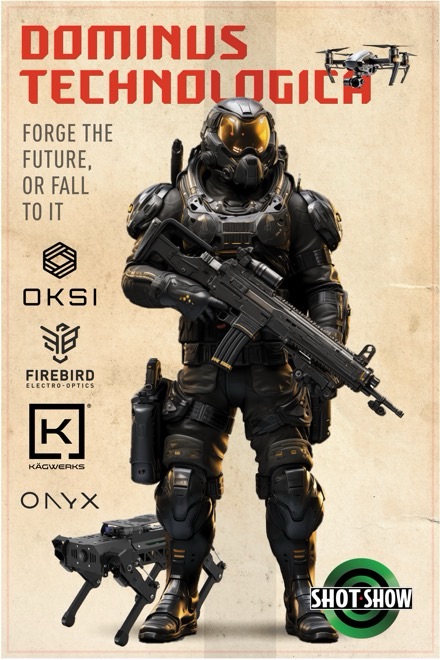
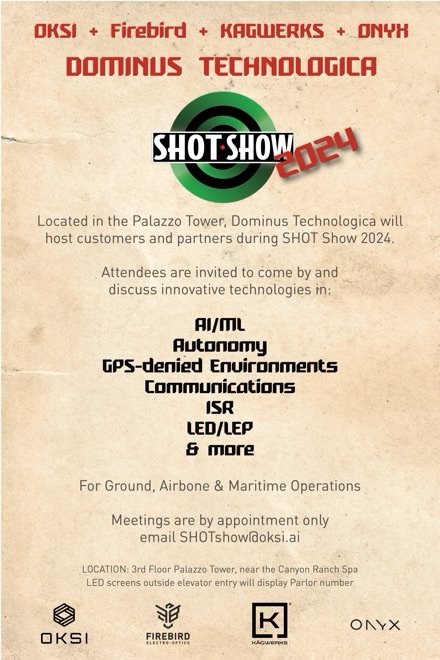
Meetings are by appointment only – email SHOTshow@oksi.ai
BARKSDALE AIR FORCE BASE, La. —
“These robot dogs not only have the potential to save Airmen’s lives, but they also serve as a reminder of how valuable your voice is, regardless of rank.”
Master Sgt. Dominic Garcia, the emergency management flight chief from the 2nd Civil Engineer Squadron, devised the concept of robot dogs and while he advanced his idea into building and testing the robots, he learned some valuable lessons along the way.
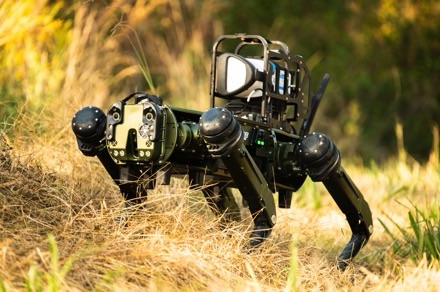
Garcia is originally from Denver, enlisted in the Air Force in 2006 and spent most of his career working under Air Force Global Strike Command.
In 2017, Garcia deployed to Syria from his home station at Dyess Air Force Base, Texas. After returning from his deployment Garcia reflected on his time in Syria.
“I had a really hard time adjusting back, and when you’re trying to adjust back, you replay a lot of things in your head,” said Garcia. “You replay certain situations, you think; what could I have done better? What could I have done differently?”

While reflecting on his deployment he remembered seeing canine teams on some of the chemical, biological, radiological, and nuclear missions. He said while he considered the things he would improve; he wondered if there was a way to arm the dogs with detectors instead of sending an entire team into a potentially hazardous environment.
In 2019, Garcia was one of six AFGSC Airmen of the Year award recipients and met people from across AFGSC. His networking led to the opportunity to bring the concept of robot dogs to life through the Air Force Work Project.
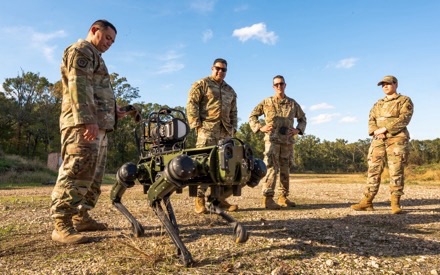
AFWERX is an Air Force innovation program that connects Airmen with technology developers to turn creative ideas into a reality. While Garcia worked on his concept with AFWERX, he connected with the company Ghost Robotics who agreed to build the robot dogs.
In 2022, Garcia and his team applied for the Silver Award Grant and they were awarded 1.25 million dollars for the project. Garcia said he was delightfully surprised as he discovered opportunities and programs as he progressed in his journey to make his robot dog idea possible.
“All I knew up until 2018 and 2019 was, if you want something done, you have to wait for policy or requirements,” said Garcia. “I didn’t know that there’s this whole other side of the Air Force that allows you to fast track and get what you need, kind of at the speed of relevancy to the tactical edge.”
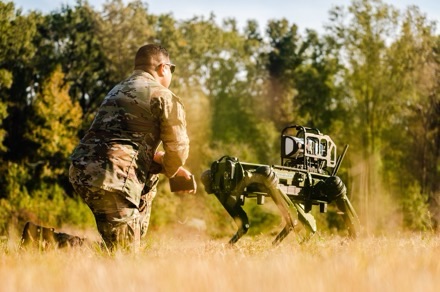
Once the robot parts were ready and delivered Garcia and his team assembled the parts into two user-friendly robotic canines.
The team tested the functionality of the newly assembled robot dogs before advancing to test their capabilities to tackle Chemical, Biological, Radiological and Nuclear materials incidents. The team tested the dogs’ CBRN readiness by putting them through radioactive sites at the Defense Nuclear Weapons School at Kirtland Air Force Base, New Mexico.
While it might seem odd to build expensive equipment and then immediately expose it to extreme situations, this testing is necessary. Garcia created the robot dogs to replace Airmen in life-threatening situations and withstand dangerous environments. He also armed the robotic canines with detectors capable of simultaneously detecting various threats.
Garcia and his team went to the Dugway Proving Grounds in Utah to test the detectors, sensor data feedback, communication, and terrain performance.
Garcia’s focus while developing the dogs was to design equipment that could save Airmen’s lives both here in the United States and when deployed overseas. He said in addition to preventing Airmen from risking their lives, the robots could fill operational gaps and increase the manpower in hazardous specialties.
Persistent to meet these goals, Garcia and his flight continue to test the robotic canines through further research and development.
Throughout the development of his robot dog concept, Garcia discovered a new passion for empowering Airmen to share their perspectives.
He emphasized the importance of listening to and encouraging different perspectives of his teammates.
“We need to be able to say yes more and listen more,” said Garcia. “We need to be able to allow our Airmen, our sergeants, our lieutenants, whoever, to be able to give those ideas and support them because if you say no you’ll never know the return on investment. But a simple yes can have so many positive effects that we don’t even see sometimes.”
Prior to his innovative journey Garcia said he didn’t know he could come up with a concept and receive the support to make it a reality.
Going through this process opened his eyes to the value of involving Airmen at every level, encouraging them, and supporting their ideas. Garcia said that is the reason he wanted to involve his teammates in the testing and evaluation of the robot dogs.
“This is one of the few times that we get to build by the end user, for the end user. Yes, end users test certain pieces of equipment, but very rarely do they get to build it out for an entire career flow for an entire mission,” said Garcia. “That’s why I wanted to create an exposure for these guys to show them that it doesn’t matter what rank you are, it doesn’t matter how much experience you have in the Air Force, we all bring something to the table.”
One of Garcia’s flight members, Airman 1st Class Daisy Slater, an emergency management specialist from the 2nd Civil Engineer Squadron, has been learning from Garcia while they work with the robot
dogs.
She said she is grateful for the opportunity to work with Garcia and learn about the dog’s performance
and capabilities.
“I feel like getting to this flight, I’ve been given the opportunity to hit the ground running, so to speak,” said Slater. “There are so many NCOs and especially Airmen coming out of this flight that are making waves in the career field. And when you situate yourself next to people doing great things, it opens a door for you to also do great things.”
Garcia said he is inspired by the adaptability and eagerness displayed by the newer generation of Airmen and he hopes he has paved a path for the many Airmen who have innovative ideas.
“The robot dogs are amazing. I love them, and I believe they’re going to save lives,” said Garcia. “What we’re doing for the career field, I think is awesome because we’re the first ones in the whole emergency management career field doing this, but the more important message is, we need to be able to be more open.”
By Airman Rhea Beil & Master Sgt. Delia Martinez, 2nd Bomb Wing
Europe’s leading robotics and autonomous systems developer Milrem Robotics and the Ukrainian Defense Industry (UDI) which consolidates national defence industry companies signed an agreement to start forging next-generation multi-domain robotic defence systems.
The agreement, signed during the First Defense Industries Forum (DFNC1) in Kyiv, details several development and manufacturing activities between Milrem Robotics and the members of UDI.
As a first step, the parties will start strategic cooperation in identifying Ukraine’s requirements and use cases for robotic systems which can enhance the capabilities of Ukraine’s armed units in the ongoing war and after the war.
Thereafter the companies involved will integrate Ukraine’s battlefield experience into Milrem Robotics’ existing robotic and autonomous systems and develop new products to create Ukraine’s manned and unmanned multi-domain capabilities.
“This unfortunate war in Ukraine has made it clear that unmanned and robotic systems have an important role on battlefield and this role will increase in time,” said Kuldar Väärsi, CEO of Milrem Robotics. “The main goal is to protect the troops and to keep the warfighters safe, but at the same time provide stronger and an asymmetric effect on the aggressor’s forces. We are honoured to cooperate with UDI to develop and manufacture robotic systems which help Ukraine win this war.”
“The First International Defence Industries Forum proved that we are on the same course as our Western partners, as Ukrainian manufacturers signed an agreement with Milrem Robotics and other global arms companies. Currently, Ukraine is gaining unique experience in Defense Tech, and we are ready to share this knowledge with our partners. We aim to deepen our cooperation with leading high-tech international companies to build the arsenal of the free world together,» said Oleksandr Kamyshin, Minister of Strategic Industries of Ukraine.
Ukrainian defence developers and manufacturers will be included to integrate their defence technology, such as weapon systems, electronic warfare and mine-clearing equipment with Milrem’s robotic vehicles to meet the requirements of the armed forces.
Additionally, the parties will look into manufacturing THeMIS Combat (with HMG and antitank capabilities), Combat Engineering (mine detection and demining), CASEVAC unmanned ground vehicles and other Milrem Robotics’ products in Ukraine and engineering cooperation in designing a wheeled Robotic Combat Vehicle.
Milrem Robotics has already delivered 15 THeMIS Unmanned Ground Vehicles to Ukraine to support logistics, casualty evacuation and route clearance operations.
Milrem Robotics is the leading European robotics and autonomous systems developer and systems integrator, with offices in Estonia, Finland, Sweden, the Netherlands and the US. The company is known for their THeMIS and Multiscope UGVs, the Type-X Robotic Combat Vehicle and the MIFIK autonomy kit.
UDI, which was transformed into a joint-stock company this summer, is a strategic manufacturer of weapons and military equipment in Ukraine and unites state-owned defence companies employing around 67,000 highly qualified employees.
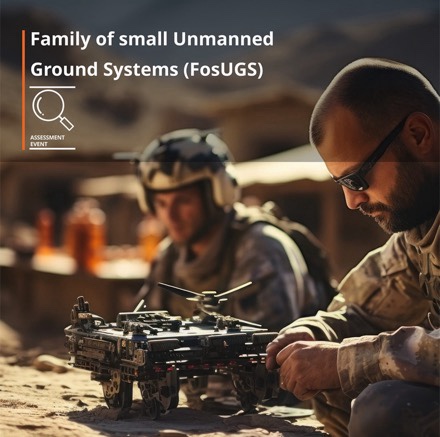
The USSOCOM Small Business Innovation Research (SBIR) program will soon be accepting submissions for the following technology areas of interest:
PHASE I:
SOCOM244-001: Small Unmanned Ground Robotic Systems
SOCOM244-002: Thermal Reflex Sight
The Small Business Technology Transfer (STTR) program stimulates a partnership of ideas and technologies between innovative SBCs and non-profit Research Institutions. By providing awards to SBCs for cooperative R/R&D efforts with Research Institutions, the SBIR and STTR programs assist the U.S. small business and research communities by supporting the commercialization of innovative technologies.
On 28 November, SOFWERX will host a virtual Q&A session for the area of interest. RSVP to the Q&A session on the event webpage.
Submissions Open 05 December 2023.
EXOM is a joint project between Mehler System and Mawishi which wishes to make good on the aspirations of USSOCOM’s so-called “Iron Man Suit” which world to beat the weight of heavy, full-body armor for breachers and the first man through the door.
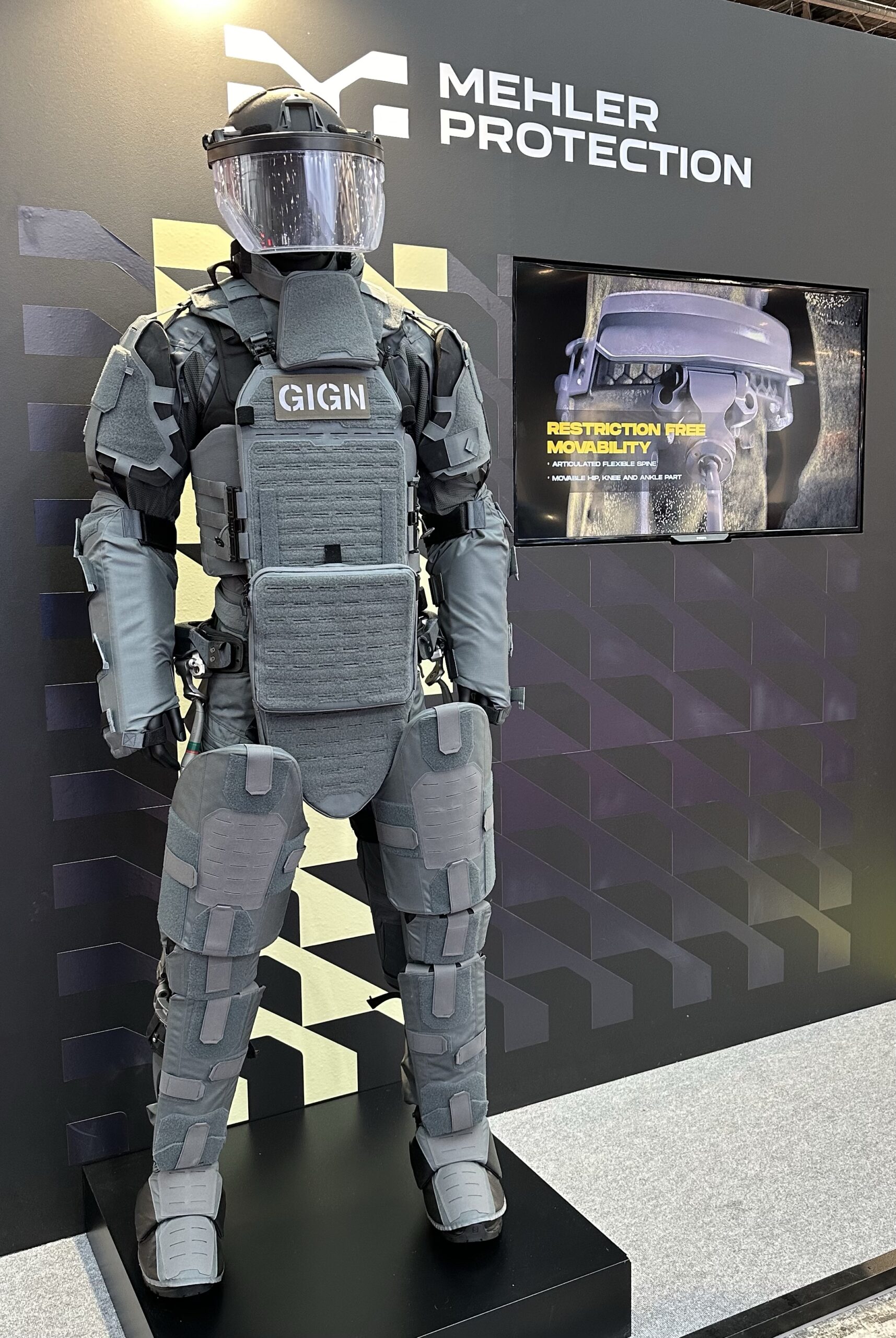
They are doing this by using the Mawishi UPRISE exoskeleton to help bear the weight and reduce fatigue, combined with Mehler’s expertise in body armor and helmets.
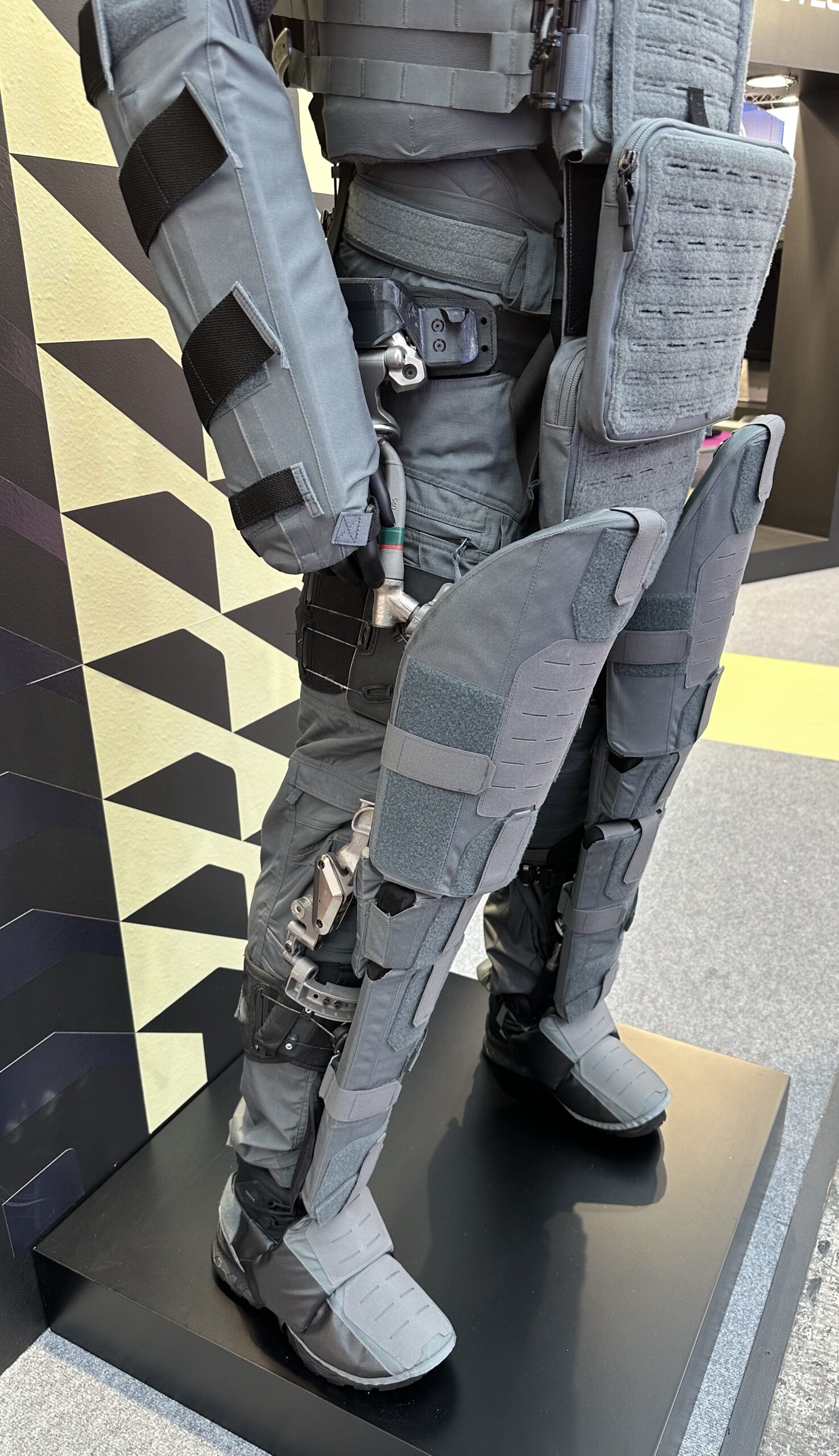
This is a very interesting international solution. British firm BCB International Ltd developed a multi-spectral camouflage appliqué for the distributor MP-Sec France to fit US-built Vision 60 Quadraped Unmanned Ground Vehicles from Ghost Robotics.
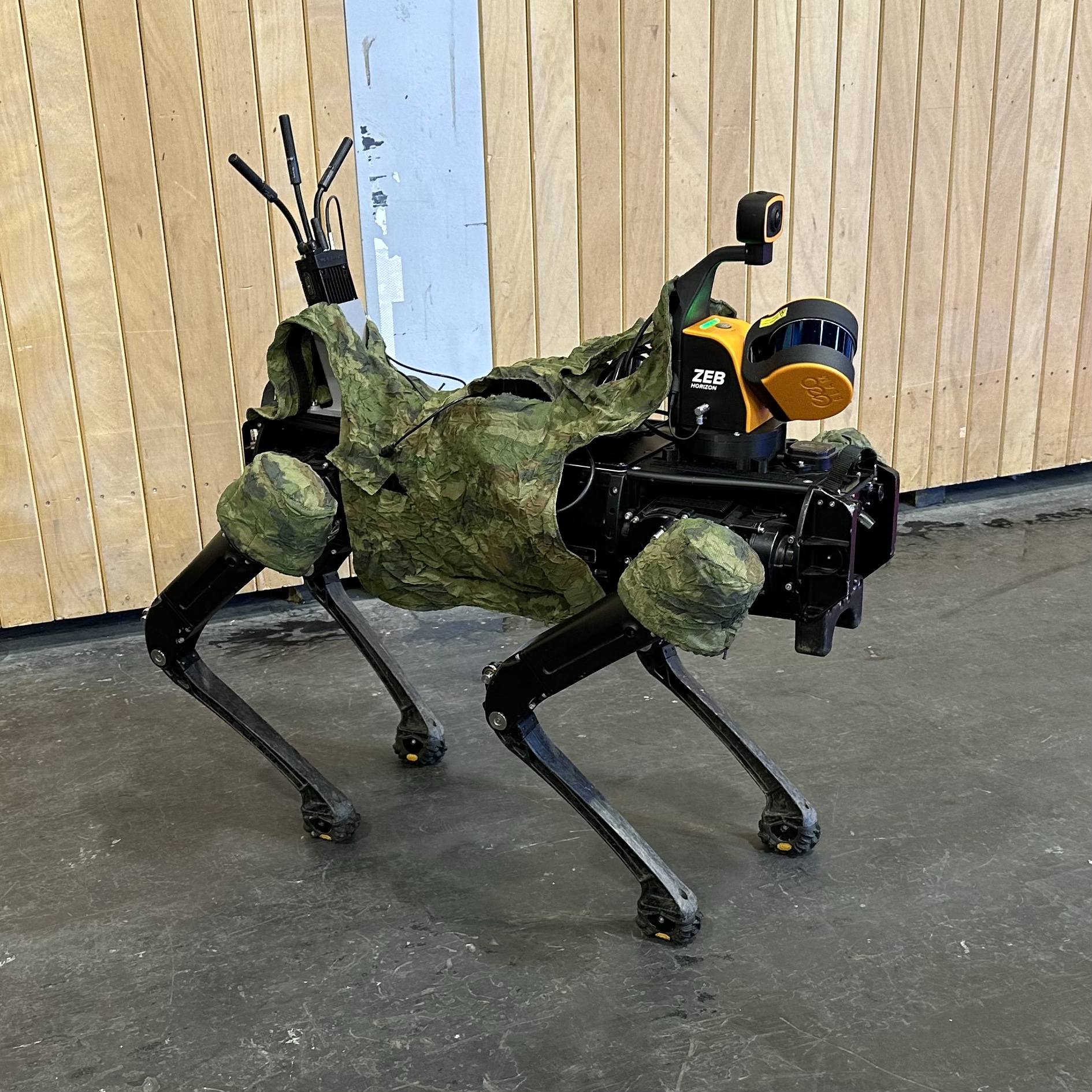
The fabric-based system is easy to apply and remove and offers camouflage in the visual, NIR, SWIR, and LWIR ranges. BCB offers CAM-Shield in a variety of visual patterns for a number of ground-based systems.
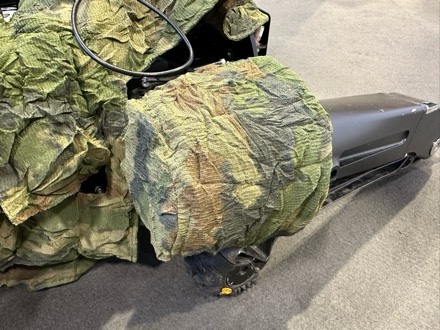
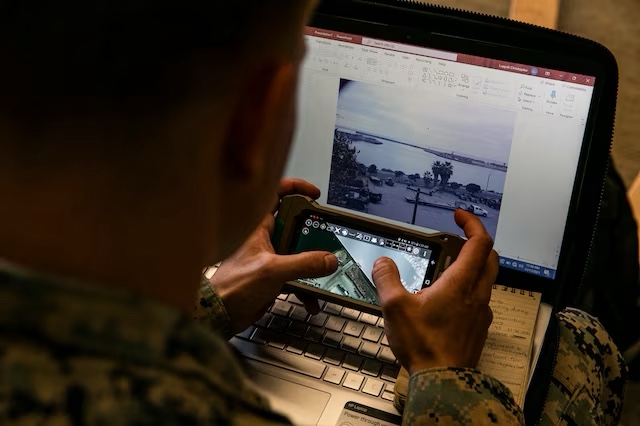
Marine Corps Base Quantico, Va. —
As the Marine Corps prepares to take the fight to the global littorals, Marine Corps Systems Command’s Program Manager for Explosive Hazard Defeat’s Littoral Explosive Ordnance Neutralization—LEON–integrated product team is working on fielding a family of systems to strengthen Marine Corps mine warfare capabilities.
Designed to address the concerns outlined in the Littoral Operations in a Contested Environment guidance, these systems fortify Marines’ mine warfare capabilities as the Corps continues with the strategic modernization outlined in former Commandant of the Marine Corps, Gen. David H. Berger’s seminal Force Design guidance.
The LEON family of systems encompasses various capabilities, among which the Explosive Ordnance Disposal Remotely Operated Vehicle—or ROV—stands out as an integral component. This innovative amphibious, unmanned robot system is specifically designed to detect, locate, reacquire, mark to avoid, render safe/neutralize, recover, exploit, and dispose of underwater explosive threats in the very shallow water, surf zone, beach zone and littoral transition points.
This bleeding-edge robotic technology—along with its integrated family of capabilities—strives to secure safe maneuverability for Marines within the littoral regions, extending support to the explosive ordnance disposal community and enhancing the overall service proficiency.
According to Product Manager for Explosive Hazard Defeat Rick Daley, LEON is a tool which will allow the support of ship-to-shore and shore-to-ship lane clearing operations more safely and effectively.
“If we aim to conduct operations as part of a MAGTF or drug task force, it necessitates a World War II style island-hopping campaign, requiring safe access to the islands. Our adversaries will be trying to stop us, though. With the advent of the LEON initiative, the strategy shifts to ‘tech to avoid’—identifying safe lanes through minefields and enabling forces to securely land on the beaches,” he said.
This innovative new system ultimately aligns with Force Design’s modernization guidance, which calls on the Corps to, “acknowledge the impacts of proliferated precision long-range fires, mines, and other smart weapons, and seek innovative ways to overcome these threat capabilities.”
The LEON team has certainly taken the call to innovate seriously. A notable facet of the team’s strength is its proactive stance towards embracing emergent technologies, thereby fostering state-of-the-art solutions tailored for the complexities of 21st-century naval warfare.
This forward-thinking approach not only underscores their commitment to enhancing maritime operational efficacy but also positions them at the vanguard of navigating the multifaceted challenges inherent in contemporary littoral combat scenarios.
According to Daley, “It’s imperative to note that unlike many unmanned capabilities, such as drones, our systems operate fully submerged. Until the acoustic communications are fully online, direct communication isn’t necessarily possible. Therefore, there’s a need for either pre-programming or having advanced software programming to enable complete autonomous operation. This allows the system to execute the required tasks and then return to a recoverable location, which is crucial. Without such measures, we’re merely deploying assets with the hope that they fulfill the intended objectives.”
“If we aim to conduct operations as part of a MAGTF or drug task force, it necessitates a World War II style island-hopping campaign, requiring safe access to the islands. Our adversaries will be trying to stop us, though. With the advent of the LEON initiative, the strategy shifts to ‘tech to avoid’—identifying safe lanes through minefields and enabling forces to securely land on the beaches,”
-Rick Daley, Product Manager for Explosive Hazard Defeat
One of the ways that the LEON team has been able to gain so much success here is through the fostering of untraditional partnerships across the Corps’ – with a special focus on direct feedback from the fleet. According to Ronald Diefenbach, LEON project officer, this has made all of the difference.
He noted, “Our collaboration with [Naval Information Warfare Center] Pacific has been pivotal in refining our platforms. Furthermore, we had the advantage of having a Marine from I Marine Expeditionary Force, I MEF, embedded with NIWC Pacific from the program’s outset, providing real-time feedback during the development process. This setup significantly bridged any communication gap, ensuring our technological advancements are aligned with practical operational needs from the very beginning of the development stage.”
Similarly, Diefenbach noted how always picking the right contract vehicle for specific parts of the project helps save time—and ultimately—taxpayer dollars. And with the LEON team moving so quickly, the future of the program certainly looks bright.
This was exemplified in a 2021 exercise when Marines from I and III MEF conducted a littoral mobility exercise, showcasing how this bleeding-edge tech can be utilized in joint-force operations with the Navy.
The collaboration between the 9th Engineer Support Battalion, 3d Marine Logistics Group, 7th ESB, 1st MLG and U.S. Navy Explosive Ordnance Disposal Mobile Unit 1 ultimately demonstrated the seamless integration of diverse capabilities to establish secure beachheads for amphibious operations.
The exercise highlighted the pivotal role of integrated capabilities in supporting naval maneuver, aligning with the tenets of Force Design 2030 to enhance real-time situational awareness and expedite decision-making in amphibious environments.
At the time, 1st Lt. Brandon Cavil, who then served as Littoral Engineer Reconnaissance Team officer in charge, noted the “exercise was all about honing the Marine Corps’ interoperability with the Navy, specifically addressing where we can provide redundant and complementary capabilities.”
Ultimately, the success of the LEON team is a testament to the foresight of the 2017 Littoral Operations in a Contested Environment document and underscores the growing importance of naval mine warfare as the Corps continues its strategic shift towards the Indo-Pacific.
This important advance in maritime technology has not gone unnoticed. In recognition for their efforts, the LEON Integrated Product Team received the Department of the Navy’s 2023 Ron Kiss Maritime Technology Transition Award, which honors outstanding achievement in the defense acquisition community for successfully transitioning a technology into a program of record or operational use.
By transcending traditional paradigms and fostering a culture of innovation and adaptability, Product Manager Explosive Hazard Defeat is not only responding to the shifting needs of the modern battlefield—it’s actively influencing the future of naval warfare. As the Marine Corps continues its strategic shift to the Indo-Pacific– guided by Force Design– the robotic technology that is being developed by the LEON team will play a vital role in navigating the dynamic and complex global littorals—ensuring the warfighter is prepared to fight and win when duty calls.
By Johannes Schmidt, Marine Corps Systems Command Office of Public Affairs and Communication | Marine Corps Systems Command
Milrem Robotics, Europe’s leading robotics and autonomous systems developer, presents a new combat UGV. The new system is the combination of Milrem Robotics’ intelligent THeMIS Unmanned Ground Vehicle (UGV) and HITROLE® Light Remote Weapon Station (RWS), one of the land turrets developed by Leonardo, a leading global Aerospace, Defence and Security company.
THeMIS Combat UGV’s provide direct fire support for manoeuvre units and act as a force multiplier. With the HITROLE® Light RWS which can be fitted with a 7,62 mm or a 12,7 mm Machine Gun or a 40 mm Automatic Grenade Launcher and is assisted by AI functions for target acquisition, recognition prioritization and tracking, they provide the capability to perform multi-role tasks like surveillance, patrolling, border security, counter-sniper and asymmetric missions. Engagement of the target is always done by a human operator.
THeMIS Combat UGVs enhance force protection and increase stand-off distance by allowing the operator to utilize the weapon system and observe, day and night from a protected position.
The HITROLE® Light RWS is a multi-role ultra-lightweight turret of which more than 300 units are in service worldwide.
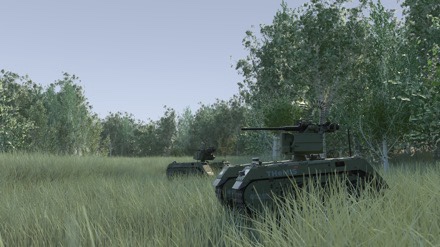
“The THeMIS has proven to be the most popular and suitable robotic mobility platform for RWS integrations. Our cooperation with Leonardo and the integration of HITROLE® represent the next crucial steps in this journey. Together with Leonardo, we can offer a highly capable robotic combat system to the Italian Army and customers worldwide. This will significantly enhance warfighting capabilities and, even more importantly, contribute to troop safety,” said Kuldar Väärsi, CEO of Milrem Robotics.
The THeMIS UGV is a multi-role unmanned system that is part of robotics programs in various configurations in 16 countries around the world, including 8 members of NATO.
Milrem Robotics is the leading European robotics and autonomous systems developer and systems integrator, with offices in Estonia, Finland, Sweden, the Netherlands, and the US. The company is known for their THeMIS and Multiscope UGVs, the Type-X Robotic Combat Vehicle and MIFIK.